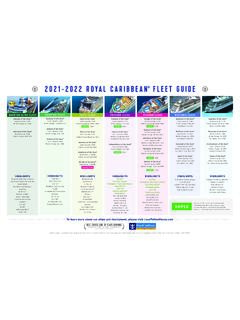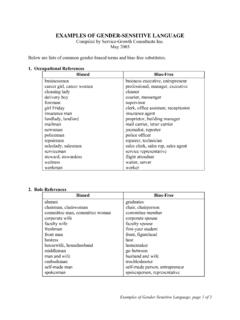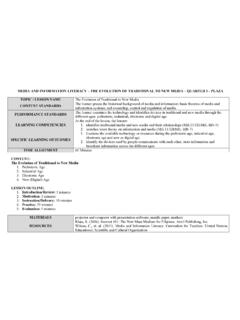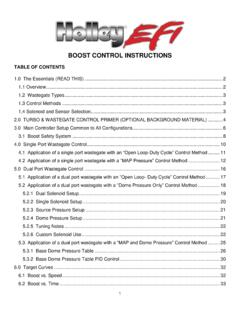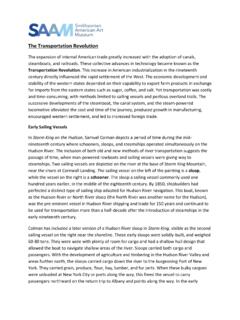Transcription of Jazz Improvisation Exercise - Central Bucks School District
1 Jazz Improvisation Exercise CBW Jazz Ensemble Audition Please navigate through the pages to follow for a step-by-step guide to this portion of your audition. Please perform 1-2 improvised choruses for the song Summertime. You may choose to compose your solo ahead of time and this is FINE! You may perform with or without accompaniment. If you want to purchase an accompaniment, one can be found in Jamey Aebersold s Vol. 54 edition entitled maiden voyage ( ). Materials are included for the following instruments. Make sure you are following the CORRECT portion for your instrument. -Concert Pitch (C) Instruments -guitar, piano, flute, vibes, trombone, bass) -all notation is provided in both treble and bass clef -Bb Transposing Instruments -Trumpet, Tenor Saxophone, and Clarinet -Eb Transposing Instruments -Alto Saxophone and Baritone Saxophone There are 2 sections in the packet, per instrument (above) -Part 1: Overview of the Improvisation method -Part 2: Chord changes and rhythm charts for Summertime This portion of the Jazz Ensemble audition is OPTIONAL, BUT ENCOURAGED!
2 Your performance on these exercises can only IMPROVE your score. You will not be penalized for opting out, but you will miss out on the opportunity to earn additional points towards your overall score. Concert Pitch InstrumentsCBW Jazz Audition- Improvisation Jazz Improvisation Audition Overview for CONCERT PITCH INSTRUMENTS (trumpets, saxes, and clarinets scroll down for your document) Each candidate for Jazz Ensemble will perform a minimum of 1 chorus (16 bars) of improvised solo over the changes for Summertime by George Gershwin. If you are not somebody who usually volunteers to take solos in your current Jazz Band, PLEASE DON T PANIC! We re going to walk you through an easy way to approach this. Improvisation Method On the main audition site ( ), you will find a link to a fairly lengthly packet that we use for the CBW Jazz Ensemble. This is a comprehensive step-by-step method.
3 It s HIGHLY recommended that you read through this method with your private teacher. There are exercises in there that can help you develop your skills as an improviser. Quick(er) walkthrough for this audition If anything appears confusing, refer to the big packet or schedule a time to work with Mr. Delson prior to the due date. Chords in Summertime* Most chords in this piece are seventh chords, which means they contain 4 notes each. A few have 5 notes and are labeled below. Chords below are built from the bottom up, just as though you were using notation. Numbers and solfeggi (do-re-mi, etc.) are used to label chord tones. Trombone, guitar, bass, piano, flute, and vibes version (Concert Pitch) 1Dm7 7- C (te) 5- A (sol) 3- F (me) 1- D (do)Em7b5 1- D (do) 6- Bb (le) 4- G (fa) 2- E (re)A7b9 6- Bb (le) 4- G (fa) 2- E (re) 7- C# (ti) 5- A (sol)D7b9 2- Eb (ra) 7- C (te) 5- A (sol) 3- F# (mi) 1- D (do)Gm7 3- F (me) 1- D (do) 6- Bb (le) 4- G (fa)C7b9 1- Db (di) 6- Bb (le) 4- G (fa) 2- E (re) 7- C (te)Fmaj7 2- E (re) 7- C (te) 5- A (sol) 3- F (me)*The chords above are all in CONCERT PITCH.
4 If you play a transposing instrument (trumpet, sax, or cln.), please see the appendix for your chords. Concert Pitch InstrumentsCBW Jazz Audition- Improvisation Part 1: Voice Leading: Tonic to Dominant Voice leading is the practice of moving one chord to another as smoothly as possible. When improvising, good voice leading generally involves the last note we play under one chord TO the first note we play in the one that follows. Tonic chords typically refer to the chord that reflects the key of the piece. Summertime is in concert D minor, so for this piece, our tonic chord is Dm7. The Dominant chord typically refers to the chord built on the fifth consecutive note in that key, so for Summertime (D minor), the Dominant chord is A7 (A is the 5th note in a D scale). We add a flat-9 to this chord to make it sound more interesting. Without going too much into WHY these movements work (refer to the big packet for that), here is the best way to move from Dominant to Tonic.
5 The arrows show the best path for the best choice for the last note to play over Dominant moving to the best choice for the first note played over Tonic. Any of these pathways work nicely. Experiment to see which you like best. There are other choices, but these are the simplest to hear and understand. Notice that all of these movements are either half or whole steps. Trombone, guitar, bass, piano, flute, and vibes version (Concert Pitch) 2Dm7 7- C (te) 5- A (sol) 3- F (me) 1- D (do)A7b9 6- Bb (le) 4- G (fa) 2- E (re) 7- C# (ti) 5- A (sol)Concert Pitch InstrumentsCBW Jazz Audition- Improvisation This song contains several secondary dominants, so there are a few more chord to chord relationships we want to look at: This voice leading all works great, but the basic point is this: Find a tone in chord #1 that is a step (half or whole) away from a tone in chord #2.
6 Make those two notes the last, then first notes you play. When you aren t worrying about voice leading, this piece GENERALLY stays in one key, which means the SAME SCALE works for almost the entire song. D minor scale* : D-E-F-G-A-Bb-C-D Even if you don t want to use any of the techniques discussed in this document, you could play a pretty convincing solo by exclusively using the notes above for the entire piece. Pretty On the next page, there are the FEW times you should make small adjustments. It will make your solo sound WAY better. See below for that info and a quick wrap up before we move to Part 2. Trombone, guitar, bass, piano, flute, and vibes version (Concert Pitch) 3D7b9 2- Eb (ra) 7- C (te) 5- A (sol) 3- F# (mi) 1- D (do)Gm7 3- F (me) 1- D (do) 6- Bb (le) 4- G (fa)C7b9 1- Db (di) 6- Bb (le) 4- G (fa) 2- E (re) 7- C (te)Fmaj7 2- E (re) 7- C (te) 5- A (sol) 3- F (me)More advanced improvisers may want to use the Dorian mode.
7 This requires more changing, but is hip if you are cool with it. Check out the big packet for more info. Concert Pitch InstrumentsCBW Jazz Audition- Improvisation Summertime- when to change notes (from the original D minor scale) A7b9: Replace C with C# D7b9: Replace F with F# (and Bb with B, but this isn t as important) -the b9 here is Eb, which you can also change, but it s not ESSENTIAL that you do this And that s pretty much it. Seriously. Part 1 Wrap Up -When moving from chord to chord, try your best to make the last note during the first chord lead nicely to the first note in the second. In some cases, the chords happen one per bar. In others, it s two per bar. -The notes in the D minor scale will work for most of the tune. Your Improvisation will sound more convincing if you make the changes, for the chords listed above. Part 2: The Rhythm Chart Method The #1 challenge for young improvisers is keeping up with how fast everything is happening when improvising.
8 The chords are changing, the rhythm section is playing, and your brain can t work fast enough to process it all with SIMULTANEOUSLY trying to play with convincing rhythm and harmony. It s because we skipped a step. We tried to spontaneously improvise a solo before we thoughtfully composed a solo. So let s try to do that now. Step 1: Pick a tune. We ve chosen Summertime for this audition. Step 2: Have your teacher compose a convincing jazz rhythm. You ll see that on the second page of your Summertime sheet with beams with slash notation. Step 3: Identify the last and first notes in places you want to voice lead. Step 4: Pre-determine which notes you want to use for your voice leading. Fill those in. Step 5: Fill in the remaining notes, making use of the proper scale tones and incorporating any of the note changes from above. Step 6: Revel in how good you sound!
9 See below for the process fleshed out. We ll use the same chords as above, but different rhythm that what you have on the audition sheet. Trombone, guitar, bass, piano, flute, and vibes version (Concert Pitch) 4 Concert Pitch InstrumentsCBW Jazz Audition- Improvisation Step 1: Here s your tune. We have isolated the first 4 bars (and beat 1 of bar 5) for this example. Step 2: Under the chords, a stylistically appropriate rhythm is provided for you. Step 3: Identify the last and first notes in places you want to voice lead. These notes occur right before the chord changes from one to another. Step 4: Determine which notes you want to use for voice leading. Use the chord chart diagrams from above to make your selection. Follow the arrows to know which note leads to which. Step 5: Fill in the remaining notes. Use (concert) D minor for everything except the 2 changes listed above.
10 Notice the use of C# in the second bar and F# in the fourth. Try to stay melodic. Big, angular jumps and skips can be awkward. Consider using chord tones to begin each bar. Trombone, guitar, bass, piano, flute, and vibes version (Concert Pitch) 5 C InstrumentsD 7E 7(b5)A7(b9)D 7D7G 7 Med SwingD 7E 7(b5)A7(b9)D 7D7(b9)G 7D 7E 7(b5)A7(b9)D 7D7(b9)G 7D 7E 7(b5)A7(b9)D 7D7(b9)G 7c&bCBW Jazz Ens Audition 2016-2017 Jazz Improvisationover the changes to Summertime&b&b&bV VJVV VJVVVVVVVVVVVV VJVVV VJVVVV # # J J # J # J see next page for the above examples in bass clef C InstrumentsD 7E 7(b5)A7(b9)D 7D7G 7 Med SwingD 7E 7(b5)A7(b9)D 7D7(b9)G 7D 7E 7(b5)A7(b9)D 7D7(b9)G 7D 7E 7(b5)A7(b9)D 7D7(b9)G 7c&bCBW Jazz Ens Audition 2016-2017 Jazz Improvisationover the changes to Summertime&b&b&bV VJVV VJVVVVVVVVVVVV VV VJVVVV # J j # n #j C InstrumentsD 7E 7(b5)A7(b9)D 7D7G 7 Med SwingD 7E 7(b5)A7(b9)D 7D7(b9)G 7D 7E 7(b5)A7(b9)D 7D7(b9)G 7D 7E 7(b5)A7(b9)D 7D7(b9)










